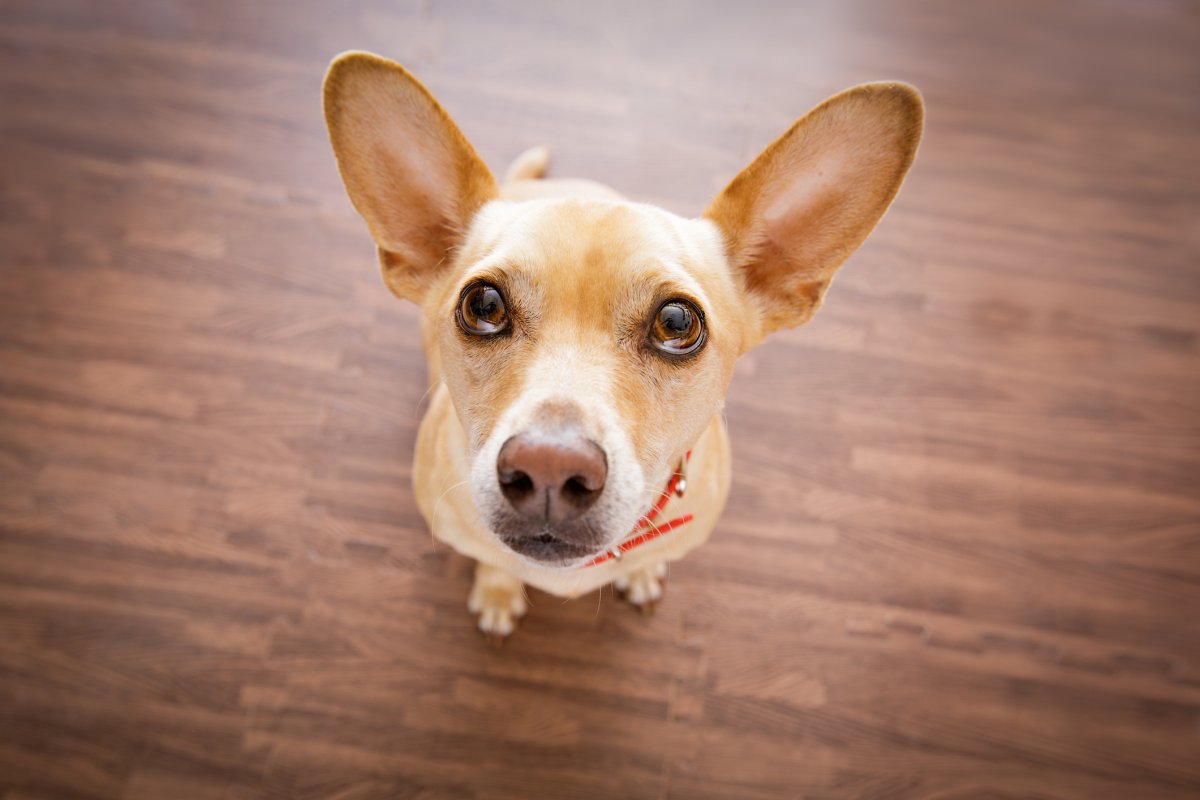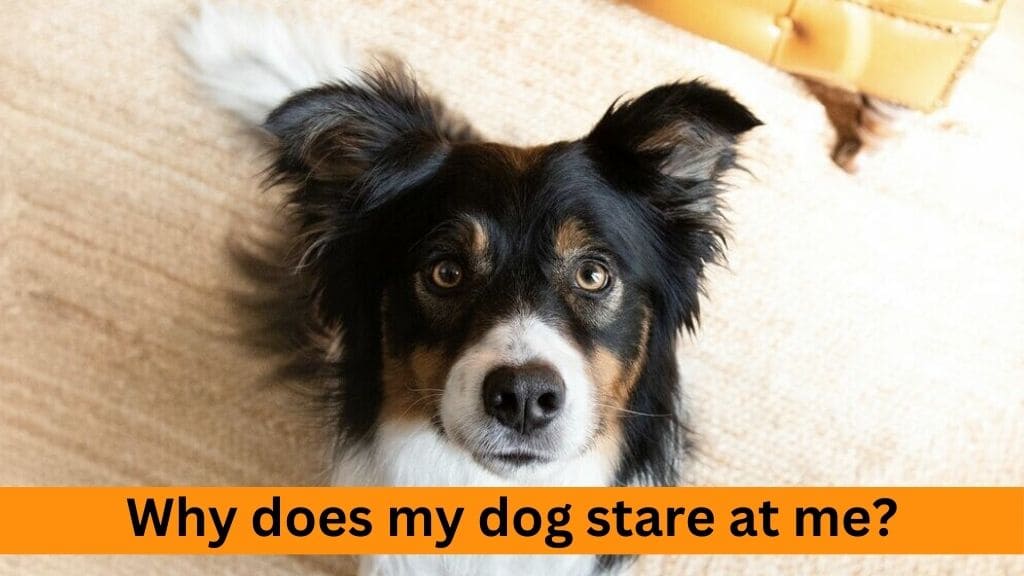Dogs are fascinating creatures with a myriad of behaviors that often leave us humans intrigued and sometimes perplexed. One such behavior that many dog owners encounter is their furry friend staring at them, sometimes for what seems like an eternity. But why do dogs do this? What is the meaning behind their intense gaze? In this comprehensive guide, we’ll delve deep into the reasons why dogs stare at their owners, exploring the various motivations behind this seemingly simple yet complex behavior.
Understanding Canine Communication

Body Language
Dogs use their bodies to convey a wide range of emotions and intentions. Understanding your dog’s body language can help you interpret their feelings and respond appropriately. Here are some key elements of canine body language:
- Tail Wagging: Contrary to popular belief, a wagging tail doesn’t always indicate happiness. The speed, height, and position of the tail can provide insights into your dog’s emotional state. For example, a low wagging tail may indicate insecurity or submission, while a high wagging tail could signify excitement or alertness.
- Ears: The position and movement of your dog’s ears can also convey important information. Forward-facing ears typically indicate attentiveness or curiosity, while flattened ears may signal fear or aggression. Pay attention to your dog’s ear position to gauge their mood and level of comfort.
- Posture: A dog’s body posture can reveal a lot about their intentions and emotions. A relaxed, loose posture suggests contentment and relaxation, while a tense or rigid posture may indicate anxiety or aggression. Take note of your dog’s overall body posture to understand their emotional state.
Facial Expressions
Just like humans, dogs use facial expressions to communicate their feelings and intentions. While dogs may not have the same range of facial expressions as humans, they can still convey a lot through their facial cues. Here are some common facial expressions in dogs:
- Relaxed Mouth: A relaxed, slightly open mouth with a loosely hanging tongue typically indicates contentment and relaxation. This expression is often seen when dogs are comfortable and at ease.
- Raised Eyebrows: Dogs can raise their eyebrows to express curiosity or concern. Raised eyebrows accompanied by forward-leaning body posture may indicate interest or anticipation.
- Bared Teeth: Bared teeth are a sign of aggression or fear in dogs. This expression, often accompanied by growling or snarling, indicates that the dog feels threatened or defensive.
Vocalizations
While dogs primarily communicate through body language and facial expressions, they also use vocalizations to convey messages. From barks and growls to whines and howls, dogs can produce a variety of sounds to express their emotions and needs. Here’s a brief overview of some common dog vocalizations:
- Barking: Barking is one of the most common vocalizations in dogs and can have various meanings depending on the context. Dogs may bark to alert their owners to potential threats, communicate excitement, or seek attention.
- Growling: Growling is often a sign of aggression or discomfort in dogs. Dogs may growl when they feel threatened, scared, or territorial. It’s essential to pay attention to the context in which growling occurs and address any underlying issues.
- Whining: Whining is a vocalization often associated with distress or anxiety in dogs. Dogs may whine when they’re in pain, feeling anxious, or seeking attention. It’s important to determine the cause of your dog’s whining and address any underlying issues promptly.
Reasons Why Dogs Stare at Their Owners
:max_bytes(150000):strip_icc()/00-sit-hero-2000-f7341ea681454e75bf223cb59c7616d0.jpg)
Seeking Attention and Interaction
Dogs are inherently social animals that thrive on companionship and interaction with their human counterparts. When a dog stares at its owner, it may be seeking attention and engagement. This stare could be their way of signaling a desire to play, cuddle, or simply receive acknowledgment from their beloved human.
Expressing Affection and Bonding
Dogs form deep emotional bonds with their owners, often akin to the bonds found in human relationships. A dog’s loving gaze can be a way of expressing affection and strengthening the bond between them and their owner. This stare communicates feelings of love, loyalty, and devotion, fostering a sense of connection and closeness.
Seeking Guidance and Reassurance
In unfamiliar or uncertain situations, dogs may look to their owners for guidance and reassurance. When faced with new environments, encounters with unfamiliar objects, or challenging situations, dogs may stare at their owners as a way of seeking direction and comfort. The owner’s presence serves as a source of security and guidance, helping the dog navigate unfamiliar territory with confidence.
Anticipating Action and Predicting Behavior
Dogs are keen observers of human behavior and routines. When a dog stares at its owner, it may be trying to anticipate their next move or understand their intentions. Dogs thrive on predictability and routine, and they may stare at their owners as a way of deciphering what comes next. This behavior stems from their innate desire to understand and predict human actions, ensuring a sense of stability and security in their environment.
Communicating Needs and Desires
Dogs are adept at communicating their needs and desires to their owners, often using a combination of vocalizations, body language, and yes, staring. When a dog stares at its owner, it may be trying to convey a specific need or desire, such as hunger, thirst, the need to go outside, or the desire for play or affection. This stare serves as a form of communication, prompting the owner to respond to the dog’s needs and ensure its well-being and happiness.
Establishing and Strengthening Bonds
Ultimately, the act of staring at their owner serves as a means for dogs to establish and strengthen bonds with their human companions. Whether it’s seeking attention, expressing affection, seeking guidance, or communicating needs, the act of locking eyes with their owner fosters a sense of connection and intimacy between dog and human. This mutual gaze creates a profound emotional bond that enriches the relationship and enhances the bond between dog and owner.
Responding to Your Dog’s Stare

Acknowledge and Engage
When your dog stares at you, it’s essential to acknowledge their presence and engage with them positively. Ignoring your dog’s stare may lead to feelings of frustration or disconnection. Instead, respond to their gaze with attention and affection. Offer a gentle pat, a kind word, or initiate a brief play session to satisfy their need for interaction. Engaging with your dog reinforces positive behavior and strengthens the bond between you.
Address Their Needs Promptly
If your dog’s stare is accompanied by signs of discomfort or distress, such as pacing, whining, or restlessness, take the time to address their needs promptly. Dogs may stare at their owners to communicate specific needs or desires, such as hunger, thirst, the need to go outside, or the desire for attention. By addressing their needs promptly and effectively, you demonstrate your care and concern for their well-being, strengthening the bond of trust between you.
Establish Clear Communication Channels
Establishing clear communication channels with your dog is essential for understanding their needs and desires. Pay attention to your dog’s body language, facial expressions, and vocalizations to decipher their messages effectively. By learning to interpret your dog’s cues and responding appropriately, you can foster a deeper connection and mutual understanding. Use positive reinforcement techniques to encourage desired behaviors and communicate effectively with your furry friend.
Strengthen the Bond Through Interaction
Interacting with your dog regularly is key to strengthening the bond between you. Use your dog’s stare as an opportunity to engage in meaningful interactions, such as playtime, training sessions, or leisurely walks. Spending quality time together strengthens the bond between you and reinforces your dog’s trust and reliance on you as their caregiver and companion. Make time each day to connect with your dog and nurture your relationship through shared activities and experiences.
Be Patient and Consistent
Building a strong bond with your dog takes time, patience, and consistency. Respond to your dog’s stare with patience and understanding, even if you’re unsure of their intentions. Be consistent in your responses and interactions, reinforcing positive behaviors and addressing any concerns or issues promptly. By providing a stable and supportive environment, you can cultivate a deep and lasting bond with your furry companion that enriches both of your lives.
Conclusion
Dogs stare at their owners for a variety of reasons, ranging from seeking attention and expressing affection to indicating needs and desires. By understanding the motivations behind this behavior and responding appropriately, you can strengthen the bond with your canine companion and ensure their happiness and well-being. Remember to pay attention to your dog’s cues and communicate effectively to foster a positive and fulfilling relationship.

